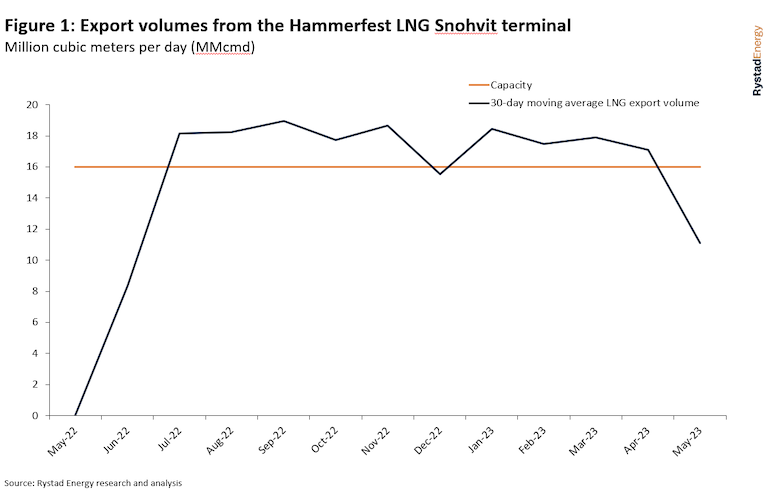Natural gas and LNG prices are falling again on muted demand and high inventories in Asia and Europe.
As a result, cancellations of US LNG cargo deliveries are not unthinkable.
However, we believe this has a low probability as global benchmarks are still well above shut-in levels in light of Henry Hub prices and the cost of liquefaction and transportation.
Global gas demand could fall to the lower end of expectations as a return in industrial demand in the European Union remains elusive.
Still, we expect the latter half of 2023 to be supported by weather-driven demand in Europe and Asia.
Europe’s gas storage is at 68%, but the spread has widened recently and is now trending 7% below the five-year maximum.
Overall, the risk of strong demand this summer will keep putting pressure on the global LNG market.
Month-ahead prices on Europe’s Title Transfer Facility (TTF) are around $7.9 per million British thermal units (MMBtu) this week, down 15% compared to last week.
The price of Asian spot LNG for July delivery fell 10% to approximately $8.8/MMBtu, primarily due to weak downstream demand during the shoulder season and high storage levels in Europe and Asia.
Monthly Asian spot LNG prices for July delivery are approximately mid-$9/MMBtu as of 30 May.
The last time Asian spot LNG prices settled at this level was in June and July 2021.
Some traders fear a further drop in prices due to limited downstream demand, although a hotter-than-normal summer could strengthen gas use for cooling, especially in Asia.
As of 28 May, EU27 storage levels were higher at around 77.37 billion cubic meters (Bcm), equivalent to 769 terawatt-hours (TWh), meaning they are approximately 68% full.
In terms of pipeline supplies into Europe, Norwegian piped gas volumes increased to 213 million cubic meters per day (MMcmd) on 30 May, up 2.2% on the week, following planned maintenance at some fields in Kaarsto and Visund.
However, ongoing and upcoming maintenance is planned at Aasta Hansteen, Dvalin, Kaarsto, Kollsnes, Ormen Lange, Oseberg, and Troll, which will put some pressure on aggregate supply from Norway to Europe.
An unplanned outage at Norne due to processing problems is impacting 6.5 MMcmd of capacity and has an uncertain duration.
Separately, gas pipeline flows from Russia into Europe totaled approximately 63 MMcmd as of 28 May, down 5% week-on-week.
Regarding liquefaction facilities, compressor failure took Norway’s 4.2 million tonnes per year (Mtpa) Hammerfest LNG Snohvit terminal offline for unplanned maintenance on 4 May.
The facility restarted on 27 May, marginally later than its initial expected restart date of 19 May.

In terms of wider global LNG supply, Nigeria exported approximately 0.28 Mt in week 21, 27% more compared to the same week in 2022.
In Western Australia, Pluto LNG has been undergoing maintenance since 25 May, with the liquefaction plant expected to restart on 19 June.
Pluto LNG’s operator Woodside confirmed the release of gas from the facility’s flare tower on 26 May but expected the turnaround schedule to be unaffected.
In the US, LNG feedgas rebounded in May as Cameron and Corpus Christi LNG returned to near full utilization in week 21.
For comparison, Corpus Christi averaged 2.2 billion cubic feet per day (Bcfd) in May 2022.
Meanwhile, Sabine Pass feedgas has dropped to 300 million cubic feet per day (MMcfd) to average 4.6 Bcfd this month, but the facility is still 100 MMcfd higher than May 2022 averages.
The US natural gas rig count declined to 137 in week 21, levels not previously seen since March 2022.
The market anticipates short-term elasticity in supply as rigs decline, but production continues to counter the trend and move higher, reaching 102 Bcfd in week 21.
Expectations of mild US weather triggering lackluster demand alongside gas production output improvements have kept the prompt month Henry Hub price steady, trading at $2.30/MMBtu as of 30 May.
US Lower 48 weather pattern proves to be a headwind for prices; we expect more volatility as the market exits shoulder season and moves firmly into the summer injection season.
However, warmer temperatures in the second of June remain possible, which could provide some upside for prices.
On the demand side, gas storage levels at major Japanese power utilities remain high at 2.48 million tonnes (Mt) as of 28 May, up 0.4% week-on-week, with some considering time swapping summer and winter cargoes.
Japan imported 1.16 Mt of LNG in week 21, down 15% year-on-year, with China importing 1.25 Mt, up 5% compared to the same week in 2022, and Thailand 0.26 Mt, some 3.7% less compared to this time last year.

Follow us on social media: